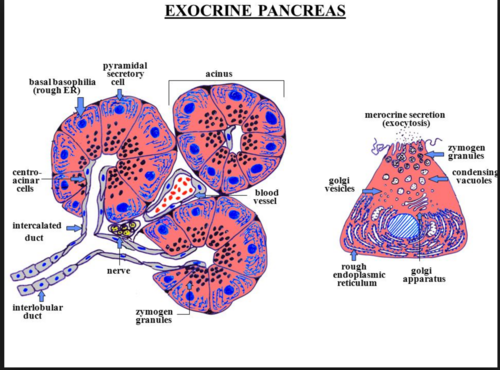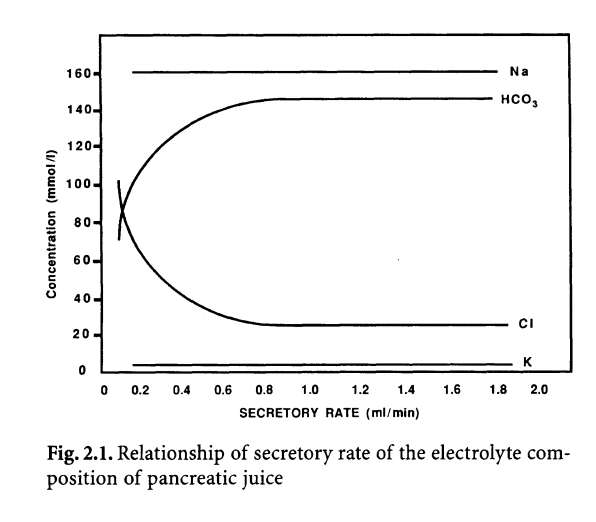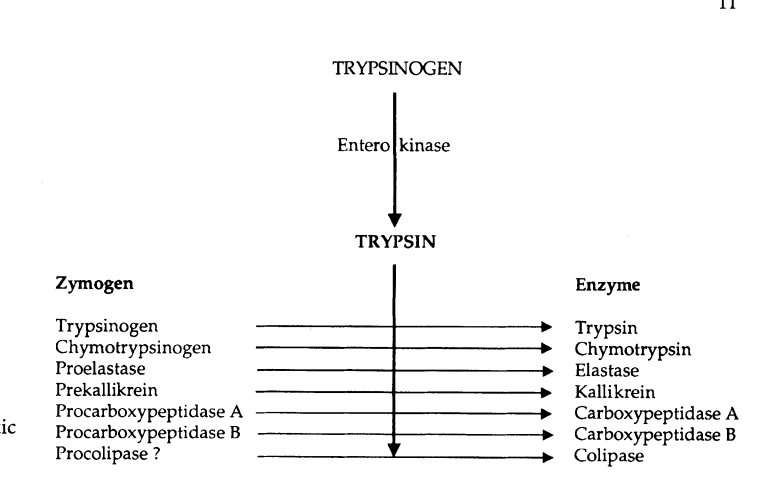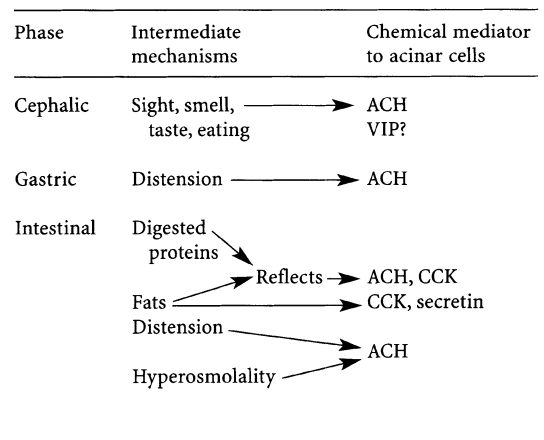U1i / 19B13: Describe the exocrine functions of the pancreas
19B13: Exam Report
Describe the exocrine functions of the pancreas.
33% of candidates passed this question.
Most candidates were able to mention some pancreatic enzymes, though often in insufficient detail to attract full marks. The amount, type, pH, etc. of pancreatic secretions was often not included. Many candidates did not describe the stimuli for pancreatic secretion. Better answers described the cephalic, gastric and intestinal phases of pancreatic secretion.
U1i / 19B13: Describe the exocrine functions of the pancreas
Definition
Exocrine describes the excretion from exocrine glands via ducts onto an epithelial surface
The Exocrine Pancreas is essential for digestion and absorption of nutrients through the secretion into proximal duodenum of digestive enzymes and bicarbonates
Structure of Exocrine Pancreas
- Acini – grapelike clusters of 6-8 acinar cells (90% of pancreatic cell population)
- Ductal system of intralobular and interlobular duct cells
- From each acinus emerges an intercalated duct
- Intercalated ducts are drained by an intralobular duct
- Finally, interlobular ducts drain into the Main Duct, which enters the duodenum
Pancreatic Juice
- 2-0.3ml/min of clear colourless liquid is secreted in the interdigestive phase
- 4ml/min is the maximal flow rate achieved after a meal in response to Secretin
- This is the main source of digestive enzymes
Water & Electrolytes
- Isotonic
- Na 160mmol/L & K 5mmol/L secreted at slightly greater concentrations cf plasma, constant and independent of secretory rates
- Cl 130mmol/L & HCO3 – concentration varies with secretion of pancreatic juice (ie low rates of HCO3 secretion 30mmo/L reach maximal 130mmol/L as flow rate increases). The concentration of Cl falls as the flow rate of HCO3 rises so the sum of both remains constant and balances the sum of K/Na secretion at all times
- Pancreatic juice also contains Mg, Zn, Sulfates and phosphates – all associated with enzymatic proteins
Proteolytic Enzymes
- Trypsinogen, chymotrypsinogen, proelastase, procarboxypeptidase (proenzymes)
- Trypsinogen = 20% of total protein content of pancreatic juice
- Enterokinase secreted by duodenal mucosa converts trypsinogen to trypsin
- Trypsin then causes more autoactivation in addition to activating many of the pancreatic zymogens into their active forms
- Released as inactive precursors packaged into zymogen granules (protects pancreas from autodigestion)
- Trypsin; hydrolyzes peptide bonds next to the basic a-acids lysine & arginine
- Chymotrypsin; hydrolyzes peptide bonds next to aromatic a-acids tryptophan, phenylalanine, tyrosine
- Kallikrein; release kinins from kininogens (kinins play an important role in the circulatory disturbances that occur in pancreatitis)
- Carboxypeptidase A & B; hydrolyse the first/last bond of peptide chains to release a-acids one by one
Lipolytic Enzymes
- Lipase; hydrolyzes triglycerades to yield two free fatty acids + monoglyceride
- Colipase (requires trypsin for activation); cofactor for lipase
- Phospholipase (trypsin to activate); hydrolyzes phospholipids → Free fatty acids + lysolethicin
Amylolytic Enzymes
- α-amylase; hydrolyses the a-1,4 linkage of dextrins to maltose & maltotriose
Nucleases
- Nucleases; hydrolyze phosphodiester bonds binding the nucleic acids
Lysosomal Enzymes
- Galactosaminidase, fucosidase, mannosidase, glucosidase, glucuronidase; lysosomal enzyme function remains unclear but are thought to modify/inactivate ligands and hormones that stimulate secretion of digestive enzymes
Lactoferrin
- Lactoferrin; an iron-binding protein normally of low concentration but markedly elevated with pancreatitis
Serum Proteins
- Albumin, IgA, IgG, IgM; migrate from the plasma via intracellular space and are found in pancreatic juice
Regulation of Pancreatic Secretion
Hormonal
Stimulate
Secretin
CCK
Gastrin
Bombesin
Vasoactive Intestinal Peptide (VIP)
Neurotensin
Inhibit
Glucagon
Pancreatic polypeptide
Somatostatin
Opiate peptides
Pancreatone
Thyrotropin-releasing hormone (TRH)
- Secretin; polypeptide hormone, released by endocrine S cells of duodenum and upper jejunal mucosa and acts on pancreatic acinar cells to secrete pancreatic fluid rich in HCO3 but low in enzyme. Duodenal pH is the major regulator of Secretin release w a threshold pH of 4.5
- CCK; polypeptide hormone which acts on acinar cells. Potently stimulates enzyme secretion but weakly stimulates HCO3 secretion. Released by products of digestion, a-acids & fatty acids, but not but undigested fat and protein. Fatty acids are the most potent stimulators of CCK release. CCK is similar in structure to Gastrin, but much more potent stimulant of pancreatic enzyme secretion because it potentiates the action of secretin on the pancreas
Neuronal
- Pancreas has dual extrinsic innervation;
- Parasympathetics via Vagus (X) Nerve
- Sympathetic via Splanchnic Nerves
- Vagal Pathways
- Cholinergic or noncholinergic
- Majority by Ach acting on muscarinic receptors
- Vagal stimulation elicits protein and HCO3 secretion
- Cholinergic neurons are also stimulated by volume and osmoreceptors in the duodenum, gastric distention and intestinal HCl
- Sympathetic
- Affect exocrine pancreatic secretion through modulating blood flow
- Sympathetic stimulation inhibits exocrine & endocrine secretion
Inhibitory
- Glucagon; inhibits pancreatic secretion stimulated by secretin/CCK
- Pancreatic polypeptide; produced by islets of Langerhans especially after meal ingestion, but also in response to CCK, gastrin and scretitin, inhibits both bicarbonate and pancreatic enzyme secretion
- Somatostatin; stongly inhibits CCK-stimulated-pancreatic enzyme secretion and modestly inhibits secretin-stimulated HCO3 release
Phases of Pancreatic Secretion
Fasting
- Under basal conditions, pancreatic secretion occurs at low rates
- Small amounts of enzymes are always present in pancreatic juice
Cephalic Phase
- Sight, smell, taste of food stimulates secretion of enzyme rich fluid
Gastric Phase
- Gastric distention stimulates pancreatic secretion mainly of enzymes
- Author: Krisoula Zahariou



